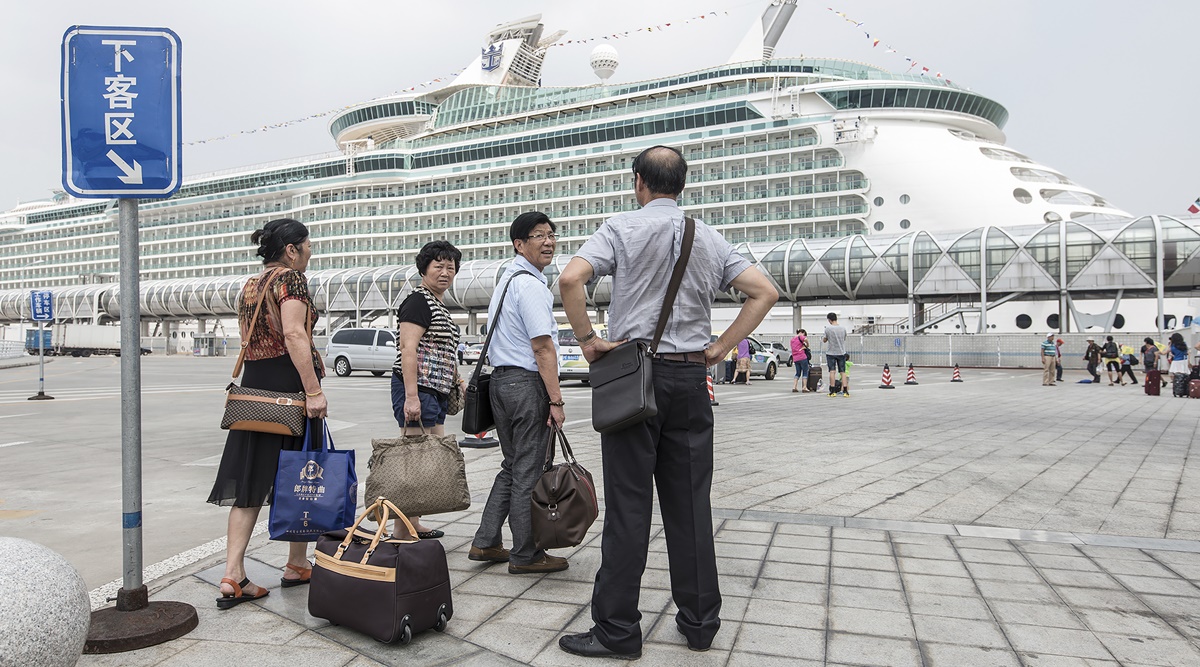 Chinese travelers outside the Shanghai International Cruise Terminal before a Royal Caribbean cruise to South Korea, Aug. 29, 2013. Even before Omicron's arrival, China was discouraging its citizens from traveling abroad, a move that has had a huge impact on global tourism. (Image/The New York Times)
Chinese travelers outside the Shanghai International Cruise Terminal before a Royal Caribbean cruise to South Korea, Aug. 29, 2013. Even before Omicron's arrival, China was discouraging its citizens from traveling abroad, a move that has had a huge impact on global tourism. (Image/The New York Times) Written by Sui-Lee Wee, Elisabetta Povoledo, Muktita Suhartono and Léontine Gallois
On Jeju Island in South Korea, the markets have gone dark. In Bangkok, bored hawkers wait around for customers who never come. In the Indonesian island of Bali, tour guides have been laid off. In Paris and Rome, the long lines of people with selfie sticks and sun hats are a distant memory.
This was supposed to be the year travel came back. In Europe and Asia, many countries reopened their airports and welcomed tourists. But they are confronting a new reality: Variants such as omicron are causing global panic, leading governments to shut borders again, and their biggest spenders — Chinese tourists — aren’t returning any time soon.
As part of its effort to maintain a zero-COVID approach, China has announced that international flights would be kept at 2.2% of pre-COVID levels during the winter. Since August, it has almost entirely stopped issuing new passports, and it has imposed a 14-day quarantine for all arrivals. Returning to China also requires mountains of paperwork and multiple COVID-19 tests.
Many people there have decided to just stay put.
No country has been more crucial to global travel in the past decade than China. Chinese tourists spent roughly $260 billion in 2019, exceeding all other nationalities. Their prolonged absence would mean travel revenues are unlikely to return to pre-pandemic levels soon. Analysts say it could take up to two years before China fully reopens.
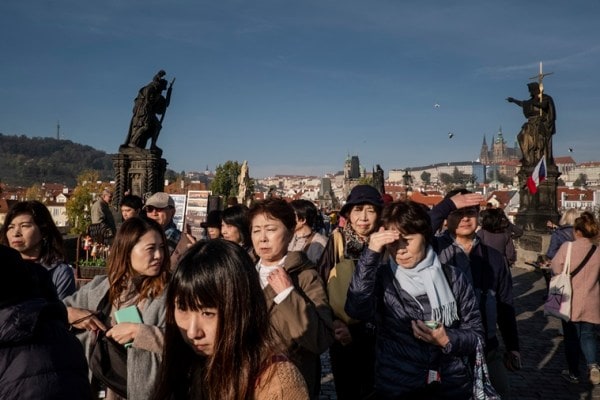 Chinese tourists visit Prague’s city center in the Czech Republic, Oct. 26, 2019. (Image/The New York Times)
Chinese tourists visit Prague’s city center in the Czech Republic, Oct. 26, 2019. (Image/The New York Times) Shopping malls have emptied out. Restaurants have shut down. Hotels are deserted.
The downturn is particularly affecting North and Southeast Asia. China is the No. 1 source of tourism in Asia for several large cities, according to Nihat Ercan, head of investment sales for the Asia Pacific at JLL Hotels & Hospitality, an adviser to the hospitality industry.
The recent discovery of omicron has prompted countries to reimpose travel restrictions or bar travelers altogether. It’s another blow to an industry that, though still reeling from the lack of Chinese tourists, was just starting to recover.
In Bangkok’s Or Tor Kor fruit market, where masses of Chinese tourists would once gather around tables eating durian, business has ground to a halt. Phakamon Thadawatthanachok, a durian seller, said she used to keep 300 to 400 kilograms of the spiky fruit in stock and had to resupply them three to four times a week to keep up with the demand. Now, she had to take a loan just to make ends meet.
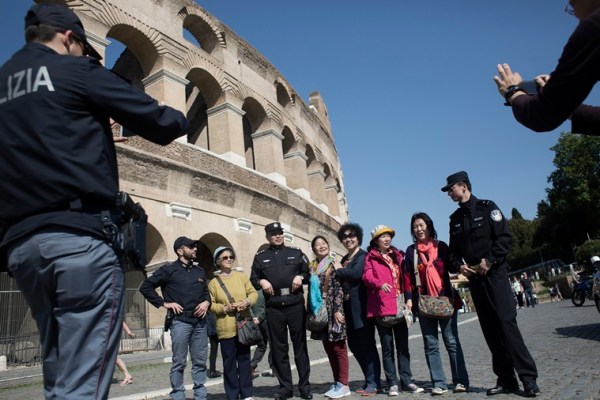 Chinese tourists in front of the Colosseum in Rome, May 5, 2016. (Image/New York Times)
Chinese tourists in front of the Colosseum in Rome, May 5, 2016. (Image/New York Times) “The loss of income is immeasurable,” she said. “At the moment, we are only holding onto the hope that it will get better someday.”
In Vietnam, the pandemic has caused over 95% of tourism businesses to close or suspend operations, according to the government.
Before the pandemic, Chinese visitors flocked to the beach towns of Da Nang and Nha Trang, accounting for around 32% of the total number of foreign tourists into the country.
“The service industry in this city has died,” said Truong Thiet Vu, director of a travel company in Nha Trang that is now shut down.
On Bali, many tourist agencies have either sold their vehicles or have had them confiscated by their leasing companies, according to Franky Budidarman, owner of one of two major travel agencies on the island that caters to Chinese tourists.
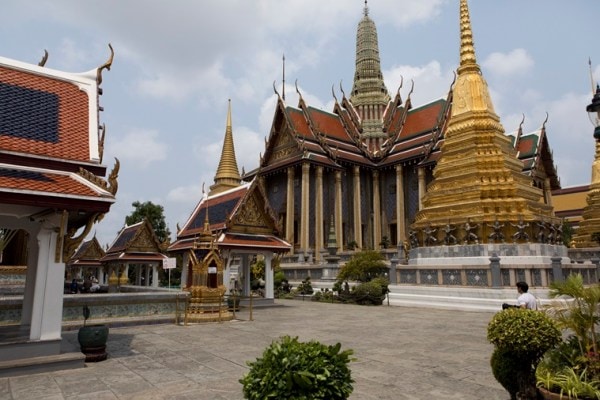 The Grand Palace, which once drew about 22,000 tourists daily, in Bangkok, March 19, 2020. (Image/The New York Times)
The Grand Palace, which once drew about 22,000 tourists daily, in Bangkok, March 19, 2020. (Image/The New York Times) Budidarman said he had to cut the salaries of his office workers by half and pivoted to running a food delivery service and a cafe. “I’m grateful that I have survived for two years now,” he said. “I sometimes wonder how I could have done this.”
For the places that catered to Chinese tourists who traveled in group packages, the loss has been especially stark. On Jeju Island, popular among Chinese visitors because they could enter without visas, the number of tourists arriving from China dropped more than 90% to 103,000 in 2020 from more than 1 million in 2019. From January to September of this year, that number was only about 5,000.
As many as half of the duty-free shops catering to Chinese tourists in Jeju have closed, according to Hong Sukkyoun, a spokesperson for the Jeju Tourism Association. At the Big Market Shopping Center, which used to sell island specialties like chocolate and crafts, all but three of 12 employees have been laid off, said An Younghoon, 33, who was among those who became jobless in July.
“When the virus began spreading, we all started counting our days down,” he said. “We knew there wasn’t going to be any business soon.”
 Outside the Louvre Museum in Paris, Dec. 4, 2020. (Image/New York Times)
Outside the Louvre Museum in Paris, Dec. 4, 2020. (Image/New York Times) Chinese visitors are less common in Europe, but they had emerged as an increasingly important market in recent years. At the Sherlock Holmes Museum in London, for example, about 1,000 people visited per day in its peak, and at least half of them were from China, said Paul Leharne, the museum’s supervisor.
Since its reopening May 17, the museum has attracted only 10% of its usual numbers. This year, it opened an online store to sell merchandise and souvenirs, about one-third of which is being shipped to China, he said.
“We really feel their absence,” said Alfonsina Russo, director of the Colosseum in Rome, referring to Chinese tourists.
Asian tourists, “especially from China,” made up around 40% of international visitors to the Colosseum in 2019, according to Russo. That year, the site had adjusted its panels and guides to include the Chinese language, along with English and Italian.
The number of international tourists arriving in Italy remains down 55%, compared with a Europe-wide drop of 48%, according to statistics issued in June by ENIT, the national tourism agency. In 2019, 2 million Chinese tourists visited Italy.
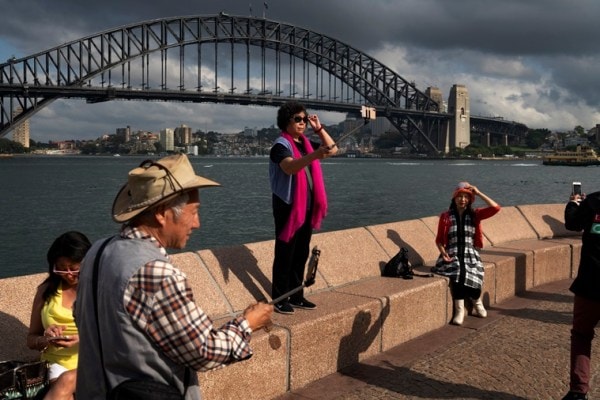 Chinese tourists in front of the Sydney Harbour Bridge, in Sydney, Australia, Jan. 14, 2019. (Image/New York Times)
Chinese tourists in front of the Sydney Harbour Bridge, in Sydney, Australia, Jan. 14, 2019. (Image/New York Times) Their disappearance has dealt “a devastating blow” to some businesses that had invested in this particular group, said Fausto Palombelli, head of the tourism section of Unindustria, a business association in the Lazio region, which includes Rome.
Like so many other places, Rome had taken steps to cater to visitors from China. It taught its taxi drivers to thank its Chinese customers with a “xie xie,” or thank you in Mandarin. Its main airport, Fiumicino, offered a personal shopping service with no value-added tax to attract Chinese travelers, according to Raffaele Pasquini, head of marketing and business development at Aeroporti di Roma, the company that manages Fiumicino.
In France, knowing that it may be months — possibly years — before Chinese tourists return, some are trying to keep a connection with potential customers.
Catherine Oden, who works for Atout France, the national institute in charge of promoting France as a tourist destination, said she had to familiarize herself with Chinese social media platforms such as Weibo and Douyin to livestream virtual activities like French cooking lessons and tours of the Château de Chantilly.
 Kuta Beach in Bali, Indonesia, March 19, 2020. (Image/New York Times)
Kuta Beach in Bali, Indonesia, March 19, 2020. (Image/New York Times) “We want to be present in their minds,” she said. “So that once everything gets back to normal, they choose France as their first destination.”
In Paris, long lines of Chinese tourists snaking around the boutiques of the Champs-Élysées used to be a common sight. “Before the pandemic, we had four Chinese-speaking salespeople,” said Khaled Yesli, 28, retail manager of a luxury boutique on the Champs-Élysées. “We only have one left and no intention to recruit any more.”
Yesli said the store’s bestselling product was once a red and gold metal box containing macarons and hand creams that was designed purposely for Chinese tourists. But with sales lackluster in the pandemic, those boxes are now on the bottom shelf.
- The Indian Express website has been rated GREEN for its credibility and trustworthiness by Newsguard, a global service that rates news sources for their journalistic standards.

